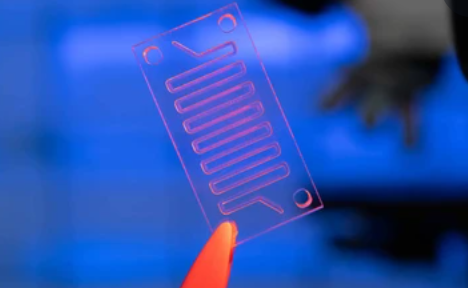Biochip Technology

Biochip may be a miniature version of a laboratory, using which quite many biochemical reactions happen simultaneously. They’re specially designed for functioning in a biological environment, especially inside living organisms. It’s not a device. Biochips contain many biosensors, which act as microreactors for detecting particular analytes like an enzyme, protein, biological molecule, and antibody.
Biochip development began with the first work on sensor technology. An American company named Affymetrix developed the primary biochip, named GeneChip, which comprises various DNA sensors used for locating defects.
The biochip has different probes like DNA, RNAi, protein fragments, etc., which are represented by some extent within the chip. These probes bind with the targets present within the sample to be tested. Due to hybridization, the contact between the probes and their target is implemented. Biochip scanners and microarray image analysis software are then used for target identification and signal quantification. The results are obtained on a statistical level and are interpreted in a biological context.

Components Of Biochip
A Biochip comprises two components, a transponder, and a reader.
Transponder
Biochips contain a passive transponder, i.e., these transponders require an electrical coffee charge to activate. The transponder consists of the following four parts.
Antenna coil: It’s fundamental and minor used for sending and receiving signals from the scanner.
Computer microchip: It stores a singular number starting from 10-15 digits.
Tuning capacitor: It’s charged with a minimal signal sent by the operator.
Glass capsule: It’s made from a biocompatible material, specifically soda-lime glass. It’s used for holding the antenna coil, capacitor, and microchip.
Reader
It consists of a coil called exciter, which is employed for creating an electromagnetic field(emf) with the assistance of radio signals. It provides the specified energy to trigger the chip. A receiving coil is present for receiving the transmitted code directed back from the excited implanted chip.
Types Of Biochips
The following three sorts of Biochips are available: –
DNA Microarray
It comprises an excessive number of small DNA spots which are fixed to a robust surface. It’s wont to calculate the expression levels for a disproportionate number of genes. Each and each DNA mark comprises probes (the picomoles of a specific gene). Generally, probe-target hybridization is observed and calculated by recognizing fluorophore (a fluorescent compound which may re-emit fall upon light excitation) labeled targets to decide on the measure of macromolecule series within the target. Innovative arrays of macromolecule were macro arrays concerning nine cm X twelve cm, and also the at the beginning, machine-driven icon-based analysis was revealed within the year 1981.
Microfluidic Chip
They are a replacement for a biochemical laboratory. They’re used for an excessive number of reactions like DNA analysis, biology procedures, and lots of more biochemical reactions. These chips are complex because they contain thousands of components. These parts are designed physically to be a bottom-up full-custom arrangement, which can be a giant workforce.
Protein Microarray
These chips are wont to track the activities and connections of proteins and seek out their function on an outsized scale. Its main advantage is that it is often used for monitoring an excessive number of proteins in parallel. This protein chip comprises a surface for supporting like microtiter plate or bead, nitrocellulose membrane, the glass slide. These are automated, fast, economical, very sensitive, consume less quantity of samples. The primary methodology of protein chips was introduced in antibody microarrays of scientific publications within the year 1983. The technology behind this chip was relatively easy to develop for DNA microarrays, which have become the foremost generally used microarrays.
Advantages & Disadvantages
Advantages
Biochips has the subsequent benefits –
- They are tiny in size and are robust and faster.
- It can perform thousands of biological reactions in a few seconds.
- Biochip also helps in various diseases.
Disadvantages
Biochips has the subsequent disadvantages –
- They are expensive.
- They can be fixed inside a person’s body even without their consent.
- They can raise serious problems of individual privacy.
Applications
- The biochip is often used for tracing any person or animal anywhere within the world.
- They are often utilized in various fields like a BP sensor, oxygen sensor within the medical field.
- These are often used for storing his personal medical and financial information.
- A biochip leads to safe E-commerce systems.
- These chips are effective in restoring the records of medical, cash, passport, etc.
- It is implanted under the skin with a unique ID number.
Working Principle of a Biochip
The working mainly includes the subsequent steps.
Step1: The operator generates a low-power electromagnetic field through radio signals
Step2: The fixed biochip gets activate
Step3: The activated chip transmits the identification code reverse to the operator through radio signals
Step4: Reader strengthens the received code to vary it into digital form and eventually exhibits it on LCD.
From the above-discussed information finally, we will conclude that biochips are accurate, fast, and miniaturized. Its space lies at the intersection between chip manufacturing, molecule biology, genomics, and signal processing. The marketplace for Biochips and its applications has been increased during several core research regions.






